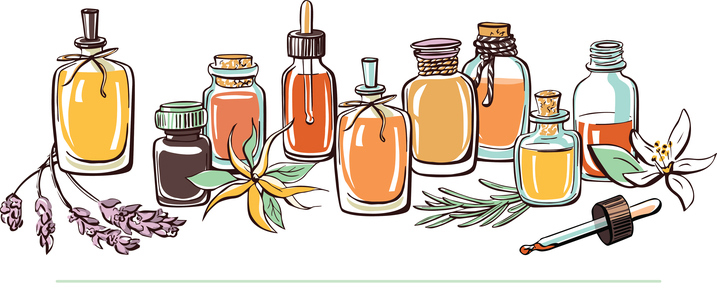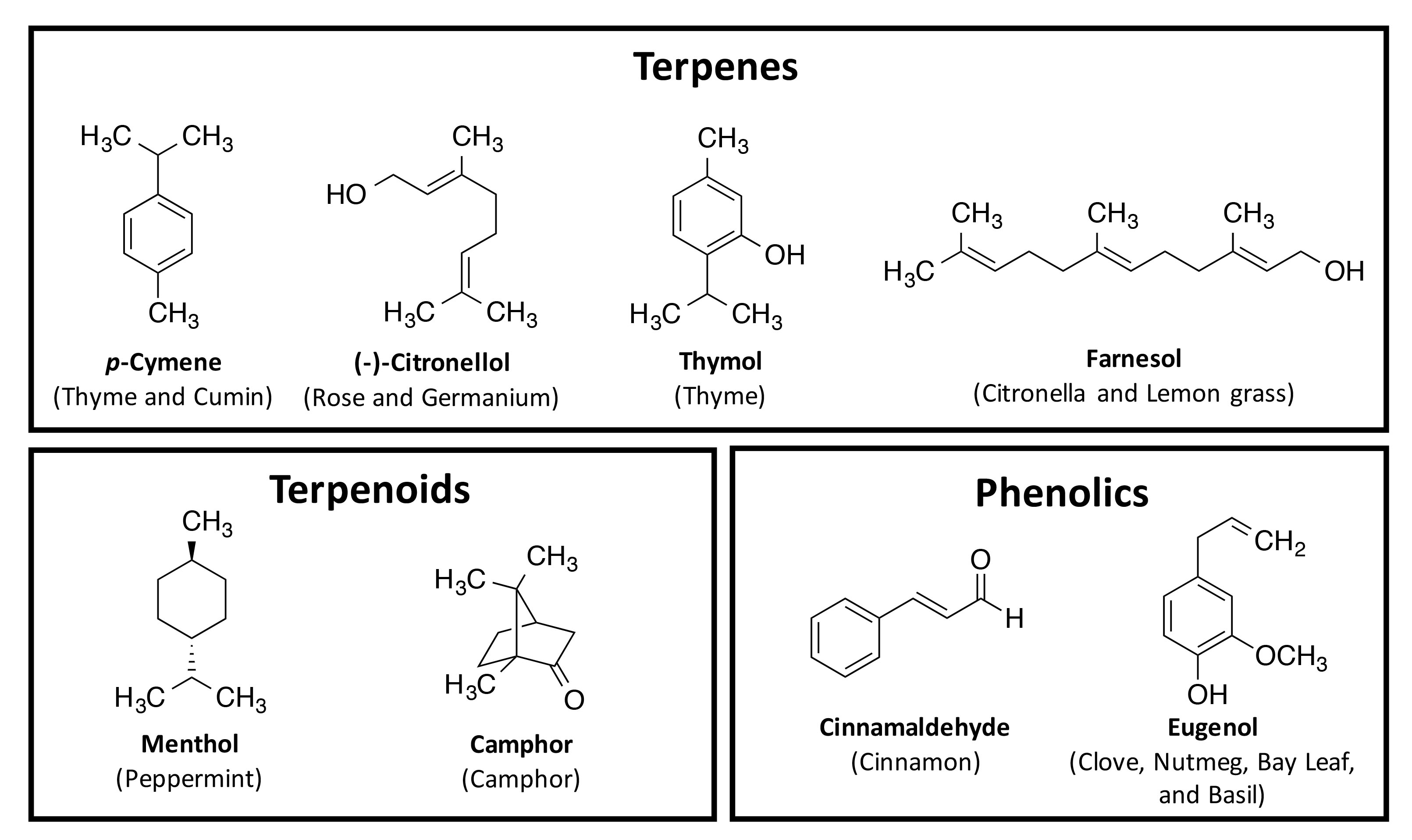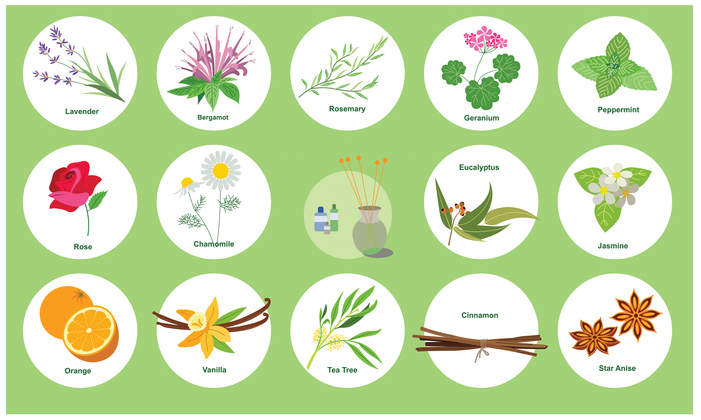

By Roger L. McMullen
April 15, 2017

Essential oils are present in flowers, leaves, stems, roots, seeds, barks, resins, and fruit rinds and often provide them with their fragrant odors.1 They are volatile substances that are obtained by distillation of the plant. Table 1 contains a list of essential oils obtained from various plant sources. Essential oils have been used in medicine, pharmacology, and cosmetics for centuries due to their antibacterial, antiviral, and antifungal properties.2 They are rich in antioxidants and usually contain terpenes and terpenoids as well as a variety of phenolic compounds (see Figure 1).3 The use of essential oils for their medicinal properties is known as aromatherapy.
Table 1. Essential oils derived from various plant components. Reproduced from V.P.S. Rao et al.1
| Leaves | Flowers | Peel | Seeds | Wood |
|---|---|---|---|---|
| Basil | Chamomile | Bergamot | Almond anise | Camphor |
| Bay leaf | Clary sage | Grape fruit | Celery cumin | Cedar |
| Cinnamon | Clove | Lemon lime | Nutmeg | Rosewood |
| Eucalyptus | Geranium | Orange | Sandalwood | |
| Lemon grass | Hyssop | Tangerine | ||
| Melaleuca | Jasmine | |||
| Oregano | Lavender | |||
| Patchouli | Manuka | |||
| Peppermint | Marjoram | |||
| Pine rosemary | Orange | |||
| Spearmint tea | Rose | |||
| Tree | Ylang-ylang | |||
| Wintergreen | ||||
| Thyme | ||||
Berries |
Bark |
Resins |
Rhizome |
Root |
| Allspice | Cassia | Frankincense | Ginger | Valerian |
| Juniper | Cinnamon | Myrrh |
The benefits of essential oils for the skin has been known for quite some time. For example, chamomile essential oil has been used for centuries as an anti-inflammatory agent and for the treatment of eczema and dermatitis.4 As another example, the broad spectrum antimicrobial activity of tea trea oil protects against bacterial, viral, fungal, and protozoal infections of the skin.5 There are a number of cases in the literature, highlighting the beneficial effects that essential oils provide to the skin.6,7 Due to the properties of essential oils already discussed, they also offer promise as wound healing agents.8
There have been a significant number of studies investigating the permeation enhancing properties of essential oils for the transdermal delivery of drugs and other agents.9-14 It is believed that essential oils function as good permeation enhancers due to their ability to compromise the lipid phase of the stratum corneum and due to any interactions they may have with stratum corneum proteins that might undergo conformational changes and weaken the skin’s barrier properties. While many essential oils have been found to be effective permeation enhancers, it is not certain to what extent this was ever really put into commercial practice in the dermatological world.

Figure 1: Molecular structures for selected components of some essential oils grouped according to their chemical class.
It should also be pointed out that essential oils have a long history of use in perfumes. While essential oils were primarily used for medicinal purposes in early history, their fragrant characteristics eventually led them to being included in many perfume preparations.15 In more recent years, several studies have appeared investigating the influence of essential oils on hair growth.16-18
It is also worth mention that essential oils have been found to have interesting effects on key molecular pathways in the body. For example, it has been shown that treatment with selected essential oils in cell-based assays suppresses cyclooxygenase-2 (COX-2) expression and activates peroxisome proliferator-activated receptors (PPARs).19-21 COX-2 is a key enzyme that initiates the inflammatory process while PPARs are transcription factors that play a major role in cellular metabolism and energy homeostasis. In skin, activation of PPARs stimulates keratinocyte differentiation. In addition, PPAR activation results in improved permeability barrier homeostasis due to a variety of factors associated with the synthesis and organization of lipids in the barrier.22

Hydrosols—also known as hydrolats or flower water—are byproducts of the distillation process of essential oils. The essential oils comprise the volatile fraction of the distillate (oil phase in the collection assembly) while hydrosols are found in the water-soluble component.23 Traditionally, the oil phase (essential oils) is retained and the water phase (hydrosol) is discarded. However, in recent years this practice has changed in part due to interest in exploiting the benefits of the hydrosol. There are many reported medicinal benefits; however, there are a limited number of scientific studies demonstrating their efficacy. Such studies should be forthcoming considering all of the recent activity involving the use of hydrosols.
The reader should be made aware that there are toxicological concerns with the use of essential oils.24-25 Care should be taken with patients who have allergies as skin irritation can occur with their use. Also, since essential oils are not standardized, the quantity of certain ingredients in a particular oil may vary from one source to the other. Overall, most of the essential oils are safe for use as they have already been vetted for consumption in the food industry. In the case of hydrosols, practictioners need to exercise extra caution as these are aqueous based systems that could become infected by microbes.
References
1. V.P.S. Rao, D. Pandey, and A. Sahoo, Extraction of essential oil and its applications, Department of Chemical Engineering, National Institute of Technology, Rourkela, India, 2007.
2. A. Djilani and A. Dicko, The therapeutic benefits of essential oils, In Nutrition, Well- Being and Health, Ed. J. Bouayed, InTech: Rijeka, Croatia; Available from: http://www.intechopen.com/books/nutrition-well-being-and-health/the-therapeutic-benefits-of-essential-oils
3. F. Bakkali, S. Averbeck, D. Averbeck, and M. Idaomar, Biological effects of essential oils—A review, Food Chem. Toxicol., 46, 446-475 (2008).
4. M.G. Miguel, Antioxidant and anti-inflammatory activities of essential oils: A short review, Molecules, 15, 9252-9287 (2010).
5. N. Pazyar, R. Yaghoobi, N. Bagherani, and A. Kazerouni, A review of applications of tea tree oil in dermatology, Int. J. Dermatol., 52, 784-790 (2013).
6. R. Kamel, H. Abbas, and A. Fayez, Diosmin/combination for dermal photo-protection using a lipoid colloidal carrier, J. Photochem. Photobiol. B, 170, 49-57 (2017).
7. O.O. Fajinmi, J. Gruz, P. Tarkowski, M.G. Kulkarni, J.F. Finnie, and J. Van Staden, Antifungal and antioxidant activities of Coleonema album and C. pulchellum against skin diseases, Pharm. Biol., 55, 1249-1255 (2017).
8. S. Asquith, The use of aromatherapy in wound care, J. Wound Care, 8, 318-320 (1999).
9. D. Montia, P. Chetonia, S. Burgalassia, M. Najarroa, M. Fabrizio Saettonea, and E. Boldrinib, Effect of different terpene-containing essential oils on permeation of estradiol through hairless mouse skin, Int. J. Pharm., 237, 209-214 (2002).
10. D. Abdullah, Q.N. Ping, and G.J. Liu, Enhancing effect of essential oils on the penetration of 5-fluorouracil through rat skin, Yao Xue Xue Bao, 31, 214-221 (1996).
11. A.C. Williams and B.W. Barry, Essential oils as novel human skin penetration enhancers, Int. J. Pharm., 57, R7-R9 (1989).
12. A.E. Edris, Pharmaceutical and therapeutic potentials of essential oils and their individual volatile constituents: A review, Phytother. Res., 21, 308-323 (2007).
13. K. Cal, Skin penetration of terpenes from essential oils and topical vehicles, Planta Med., 72, 311-316 (2006).
14. A. Herman and A.P. Herman, Essential oils and their constituents as skin penetration enhancer for transdermal drug delivery: A review, J. Pharm. Pharmacol., 67, 473-485 (2015).
15. J. Knowlton and S. Pearce, Handbook of Cosmetic Science and Technology, 1st ed., Elsevier: Oxford, UK (1993).
16. G.-S. Lee, E.-J. Hong, K.-S. Gwak, M.-J. Park, K.-C. Choi, I.-G. Choi, J.-W. Jang, and E.-B. Jeung, The essential oils of Chamaecyparis obtusa promote hair growth through the induction of vascular endothelial growth factor gene, Fitoterapia, 81, 17-24 (2010).
17. J.I. Yoon, S.M. Al-Reza, and S.C. Kang, Hair growth promoting effect of Zizyphus jujuba essential oil, Food Chem. Toxicol., 48, 1350-1354 (2010).
18. L.O. Orafidiya, E.O. Agbani, K.A. Adelusola, E.O. Iwalewa, O.A. Adebanji, E.A.F. Adediran, and N.T. Agbani, A study on the effect of the leaf essential oil of Ocimum gratissimum Linn. on cyclophosphamide-induced hair loss, Int. J. Aromather., 14, 119-128 (2004).
19. M. Hotta, R. Nakata, M. Katsukawa, K. Hori, S. Takahashi, and H. Inoue, Carvacrol, a component of thyme oil, activates PPARalpha and gamma and suppresses COX-2 expression, J. Lipid Res.,51, 132-139 (2010).
20. M. Katsukawa, R. Nakata, S. Koeji, K. Hori, S. Takahashi, and H. Inoue, Citronellol and geraniol, components of rose oil, activate peroxisome proliferator-activated receptor α and γ and suppress cyclooxygenase-2 expression, Biosci. Biotechnol. Biochem., 75, 1010-1012 (2011).
21. M. Katsukawa, R. Nakata, Y. Takizawa, K. Hori, S. Takahashi, and H. Inoue, Citral, a component of lemongrass oil, activates PPARα and γ and suppresses COX-2 expression, Biochim. Biophys. Acta, 1801, 1214-1220 (2010).
22.
M. Schmuth, Y.J. Jiang, S. Dubrac, P.M. Elias, and K.R. Feingold, Thematic review series: skin lipids. Peroxisome proliferator-activated receptors and liver X receptors in epidermal biology, J. Lipid Res., 49, 499-509 (2008).
23. S. Aazza, B. Lyoussi, and M.G. Miguel, Antioxidant activity of eight hydrosols from Morocco, Asian J. Plant Sci., DOI: 10.3923/ajps (2012).
24. S. Mortimer and M. Reeder, Botanicals in dermatology: essential oils, botanical allergens, and current regulatory practices, Dermatitis, 27, 317-324 (2016).
25. A.C. de Groot and E. Schmidt, Tea tree oil: contact allergy and chemical composition, Contact Dermatitis, 75, 129-143 (2016).